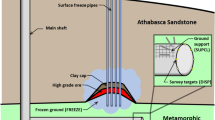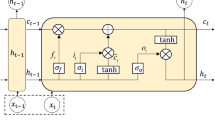Abstract
As underground instrumentation improves and the storage of large volumes of data becomes more cost effective, the rock engineering community has access to larger datasets than ever before. Machine learning algorithms (MLAs) present an opportunity to uncover nuanced rock mass deformation mechanics more efficiently than conventional data analysis tools, resulting in increased reliability of underground excavations. MLAs require appropriate pre-processing of inputs as well as ground truth validation of outputs. Convolutional Neural Networks (CNNs) are an MLA that allow for the preservation of spatial and temporal dependencies within a dataset. CNNs were developed for image recognition and segmentation, such as video processing, and are efficient at analyzing sequential snapshots of an excavation as the environmental and in-situ factors change. Herein a CNN is developed for Cigar Lake Mine, Saskatchewan, Canada, to predict tunnel liner yield. The mine experiences a complex time-dependent ground squeezing behaviour resulting from the poor geological conditions and the artificial ground freezing implemented to stabilize the ore cavities and to control ground water during the ore extraction process. A sensitivity analysis of the CNN training parameters, called hyperparameters, is completed to optimize the final CNN performance. Hyperparameters analyzed include: the amount of training data, the convolutional filter size, and the error weighting scheme. Two final models are developed, one balanced model able to accurately predict tunnel liner yield across all classes of severity, and one targeted model that is calibrated to predict the higher classes of tunnel liner yield particularly well. Model results demonstrate that the CNN is a promising tool for preserving the spatial and temporal dependencies between input variables, and for predicting tunnel liner yield. This is a novel approach for geomechanical datasets. In combination, the two final CNNs achieve a prediction precision of > 87% across all classes and a recall of up to 99.9% for the higher yield classes. The activation strengths of the inputs were studied, and it was determined that the primary installed support class is the most dominant predictor of tunnel liner yield.















Similar content being viewed by others
References
Afraei S, Shahriar K, Madani SH (2019a) Developing intelligent classification models for rock burst prediction after recognizing significant predictor variables, Section 1: literature review and data preprocessing procedure. Tunn Undergr Sp Technol 83:324–353. https://doi.org/10.1016/j.tust.2018.09.022
Afraei S, Shahriar K, Madani SH (2019b) Developing intelligent classification models for rock burst prediction after recognizing significant predictor variables, Section 2: designing classifiers. Tunn Undergr Sp Technol 84:522–537. https://doi.org/10.1016/j.tust.2018.11.011
Baecher GB, Christian JT (2003) Reliability and statistics in geotechnical engineering. Wiley, West Sussex
Barla G (2002) Tunnelling under squeezing rock conditions. Adv Geotech Eng Tunn 5:169–268
Barla G, Borgna S (1999) Squeezing behaviour of tunnels: a phenomenological approach. Gallerie 58:39–60
Barla G, Bonini M, Semeraro M (2011) Analysis of the behaviour of a yield-control support system in squeezing rock. Tunn Undergr Sp Technol 26(1):146–154. https://doi.org/10.1016/j.tust.2010.08.001
Barton NR, Lien R, Lunde J (1974) Engineering classification of rock masses for the design of tunnel support. Rock Mech 6(4):189–236
Bell J (2015) Chapter 5: artificial neural networks. In: machine learning : hands-on for developers and technical professionals (2nd Editio). https://doi.org/10.1002/9781119183464
Bieniawski ZT (1993) Chapter 22: Classification of rock masses for engineering: the RMR system and future trends. In: Konietzky H (ed) Comprehensive rock engineering. Freiberg, Germany, pp 553–573
Bishop S, Goddard G, Mainville A, Paulsen E (2012) Cigar Lake Project Northern Saskatchewan, Canada, pp 1–196
Bizjak KF, Petkovšek B (2004) Displacement analysis of tunnel support in soft rock around a shallow highway tunnel at Golovec. Eng Geol 75(1):89–106. https://doi.org/10.1016/j.enggeo.2004.05.003
Bozorgzadeh N, Escobar MD, Harrison JP (2018) Comprehensive statistical analysis of intact rock strength for reliability-based design. Int J Rock Mech Min Sci 106(May 2017):374–387. https://doi.org/10.1016/j.ijrmms.2018.03.005
Dong L, Li X, Xu M, Li Q (2011) Comparisons of random forest and Support Vector Machine for predicting blasting vibration characteristic parameters. Procedia Eng 26:1772–1781. https://doi.org/10.1016/j.proeng.2011.11.2366
Ferentinou M, Fakir M (2018) Integrating Rock Engineering Systems device and Artificial Neural Networks to predict stability conditions in an open pit. Eng Geo 246:293–309. https://doi.org/10.1016/j.enggeo.2018.10.010
Golder Associates (2001) Numerical analysis to estimate stresses in crosscut linings at Cigar Lake mine. Golder Associates, Calgary
Hoek E (1966) Rock mechanics—an introduction for the practical engineer Parts I, II and III. Min Magazine 1–67
Janeras M, Jara JA, Royán MJ, Vilaplana JM, Aguasca A, Fàbregas X et al (2017) Multi-technique approach to rockfall monitoring in the Montserrat massif (Catalonia, NE Spain). Eng Geol 219:4–20. https://doi.org/10.1016/j.enggeo.2016.12.010
Jefferson CW, Thomas DJ, Gandhi SS, Ramaekers P, Delaney G, Brisbin D et al (2007) Unconformity-associated uranium deposits of the Athabasca basin, Saskatchewan and Alberta. Bull Geol Surv Can 588:23–67. https://doi.org/10.4095/223744
Jing L, Hudson JA (2002) Numerical methods in rock mechanics. Int J Rock Mech Min Sci 39:409–427
Khan UT, Valeo C (2016) Dissolved oxygen prediction using a possibility theory based fuzzy neural network. Hydrol Earth Syst Sci 20:2267–2293. https://doi.org/10.5194/hess-20-2267-2016
Khan UT, Valeo C (2017) Optimising fuzzy neural network architecture for dissolved oxygen prediction and risk analysis. Water (switzerland). https://doi.org/10.3390/w9060381
Khan UT, He J, Valeo C (2018) River flood prediction using fuzzy neural Networks: an investigation on automated network architecture. Water Sci Technol 2017(1):238–247. https://doi.org/10.2166/wst.2018.107
Kumar M, Samui P (2014) Analysis of epimetamorphic rock slopes using soft computing. J Shanghai Jiaotong Univ (science) 19(3):274–278. https://doi.org/10.1007/s12204-014-1499-1
Kumar M, Samui P, Naithani AK (2013) Determination of uniaxial compressive strength and modulus of elasticity of travertine using machine learning techniques. Int J Adv Soft Comput Appl 5(3)
Langford JC, Diederichs MS (2013) Reliability based approach to tunnel lining design using a modified Point Estimate Method. Int J Rock Mech Min Sci 60:263–276. https://doi.org/10.1016/j.ijrmms.2012.12.034
LeCun Y, Boser B, Denker JS, Henderson D, Howard RE, Hubbard W, Jackel LD (1989) Backpropagation applied to handwritten zip code recognition. Neural Comput 1(4):541–551. https://doi.org/10.1162/neco.1989.1.4.541
Leu SS, Chen CN, Chang SL (2001) Data mining for tunnel support stability: neural network approach. Automat Constr 10(4):429–441. https://doi.org/10.1016/S0926-5805(00)00078-9
Liu K, Liu B (2017) Optimization of smooth blasting parameters for mountain tunnel construction with specified control indices based on a GA and ISVR coupling algorithm. Tunn Undergr Sp Technol. https://doi.org/10.1016/j.tust.2017.09.007
Liu F, Yang M (2005) Verification and validation of artificial neural networks. In: Zhang S, Jarvis R (Eds), AI 2005: advances in artificial intelligence. Lecture notes in computer science, vol 3809. (pp 1041–1046). https://doi.org/10.1007/11589990_137
Mahdevari S, Torabi SR (2012) Prediction of tunnel convergence using Artificial Neural Networks. Tunn Undergr Sp Technol 28(1):218–228. https://doi.org/10.1016/j.tust.2011.11.002
Marsland S (2014) Machine learning: an algorithmic perspective. In: machine learning: an algorithmic perspective, second edition. https://doi.org/10.1201/b17476
Martz P, Cathelineau M, Mercadier J, Boiron MC, Jaguin J, Tarantola A et al (2017) C–O–H–N fluids circulations and graphite precipitation in reactivated Hudsonian shear zones during basement uplift of the Wollaston-Mudjatik transition zone: example of the Cigar Lake U deposit. Lithos 294–295(October):222–245. https://doi.org/10.1016/j.lithos.2017.10.001
Millar D, Clarici E (2002) Investigation of back-propagation artificial neural networks in modelling the stress-strain behaviour of sandstone rock. Genet Sel Evol 47:3326–3331. https://doi.org/10.1109/icnn.1994.374770
Morgenroth J, Khan UT, Perras MA (2019) An overview of opportunities for machine learning methods in rock mechanics. Geosci J 9(12):504–524
Morgenroth J, Perras MA, Khan UT (2020a) Convolutional Neural Networks for predicting tunnel support and liner performance: Cigar Lake Mine case study. In: Proceedings of the 54th US Rock Mechanics/Geomechanics Symposium. Golden
Morgenroth J, Perras MA, Khan UT, Vasileiou A (2020b) An Artificial Neural Network approach for predicting rock support damage at Cigar Lake mine : a case study. In: ISRM International Symposium Eurock 2020 – Hard Rock Engineering. Trondheim, Norway
Papadopoulos G, Edwards PJ, Murray AF (2000) Confidence estimation methods for neural networks : a practical comparison. In: ESANN’2000 Proceedings—European Symposium on Artificial Neural Networks, 75–80. Belgium
Paudel B, Jafarpour M, Brummer R (2012) Cigar Lake mine MDS tunnel liner loading analysis at Cameco. ITASCA International Inc, Sudbury
Pu Y, Apel DB, Lingga B (2018) Rockburst prediction in kimberlite using decision tree with incomplete data. J Sustain Min 17(3):158–165. https://doi.org/10.1016/j.jsm.2018.07.004
Qi C, Fourie A, Du X, Tang X (2018) Prediction of open stope hangingwall stability using random forests. Nat Hazards 92(2):1179–1197. https://doi.org/10.1007/s11069-018-3246-7
Parson Brinkerhoff Quade and Douglas I (1997) Cigar Lake mine ground support and excavation method study
Ribeiro e Sousa L, Miranda T, Leal e Sousa R, Tinoco J (2017) The use of data mining techniques in rockburst risk assessment. Engineering 3(4):552–558. https://doi.org/10.1016/J.ENG.2017.04.002
Roworth M (2013) MASc Thesis—understanding the effect of freezing on rock mass behaviour as appllied to the cigar lake mining method
Seif G (2018) Handling imbalanced datasets in deep learning. Retrieved August 8, 2020, from Towards Data Science website: https://towardsdatascience.com/handling-imbalanced-datasets-in-deep-learning-f48407a0e758
Singh VK, Singh D, Singh TN (2001) Prediction of strength properties of some schistose rocks from petrographic properties using artificial neural networks. Int J Rock Mech Min Sci. https://doi.org/10.1016/S1365-1609(00)00078-2
Sklavounos P, Sakellariou M (1995) Intelligent classification of rock masses. Trans Inf Commun Technol 8:387–393
Snieder E, Shakir R, Khan UT (2019) A comprehensive comparison of four input variable selection methods for artificial neural network flow forecasting models. J Hydrol. https://doi.org/10.1016/j.jhydrol.2019.124299
Solomatine DP, Ostfeld A (2008) Data-driven modelling: some past experiences and new approaches. J Hydroinform. https://doi.org/10.2166/hydro.2008.015
Song ZP, Jiang AN, Jiang ZB (2015) Back analysis of geomechanical parameters using hybrid algorithm based on difference evolution and extreme learning machine. Math Probl Eng. https://doi.org/10.1155/2015/821534
Sun Y, Feng X, Yang L (2018) Predicting tunnel squeezing using multiclass support vector machines. Adv Civ Eng 2018:17–20. https://doi.org/10.1155/2018/4543984
The Math Works Inc. (2019) MATLAB R2019b 9.7.0.1261785
Zeiler MD, Fergus R (2014) Visualizing and understanding convolutional network. In: Fleet D, Pajdla T, Schiele B, Tuytelaars T (Eds.), Computer Vision – ECCV 2014. Lecture Notes in Computer Science, vol 8689 (Vol. 12, pp 818–833). https://doi.org/10.1007/978-3-319-10590-1_53
Zhao K, Bonini M, Debernardi D, Janutolo M, Barla G, Chen G (2015) Computational modelling of the mechanised excavation of deep tunnels in weak rock. Comput Geotech 66:158–171. https://doi.org/10.1016/j.compgeo.2015.01.020
Acknowledgements
The authors would like to extend special thanks to Cameco, and particularly Chris Twiggs, Imre Bartha and Kirk Lamont for their constructive feedback and informative conversations. This work is funded in part by the Natural Sciences and Engineering Research Council of Canada through the Discovery Grant program and the joint Innovation York and National Research Council Canada’s Industry Research Assistance Program – Artificial Intelligence Industry Partnership Fund, in partnership with Yield Point Inc. This work is also funded by the Ontario Graduate Scholarship (OGS) program.
Author information
Authors and Affiliations
Corresponding author
Additional information
Publisher's Note
Springer Nature remains neutral with regard to jurisdictional claims in published maps and institutional affiliations.
Appendix
Appendix
Rights and permissions
About this article
Cite this article
Morgenroth, ., Perras, .A. & Khan, .T. A Convolutional Neural Network Approach for Predicting Tunnel Liner Yield at Cigar Lake Mine. Rock Mech Rock Eng 55, 2821–2843 (2022). https://doi.org/10.1007/s00603-021-02563-3
Received:
Accepted:
Published:
Issue Date:
DOI: https://doi.org/10.1007/s00603-021-02563-3








